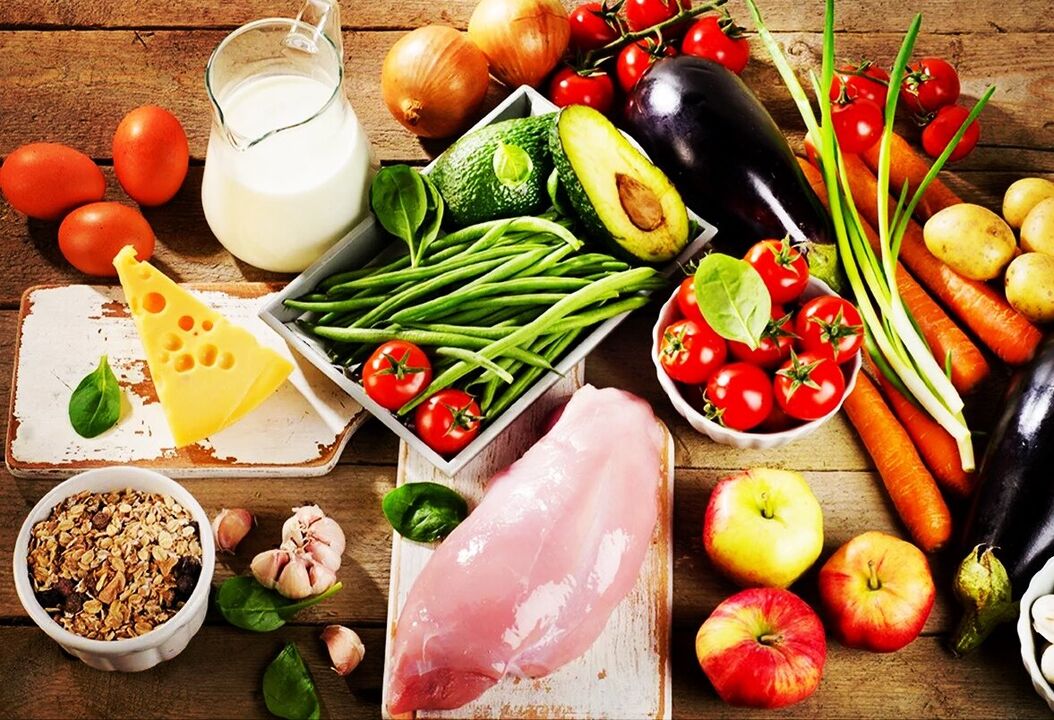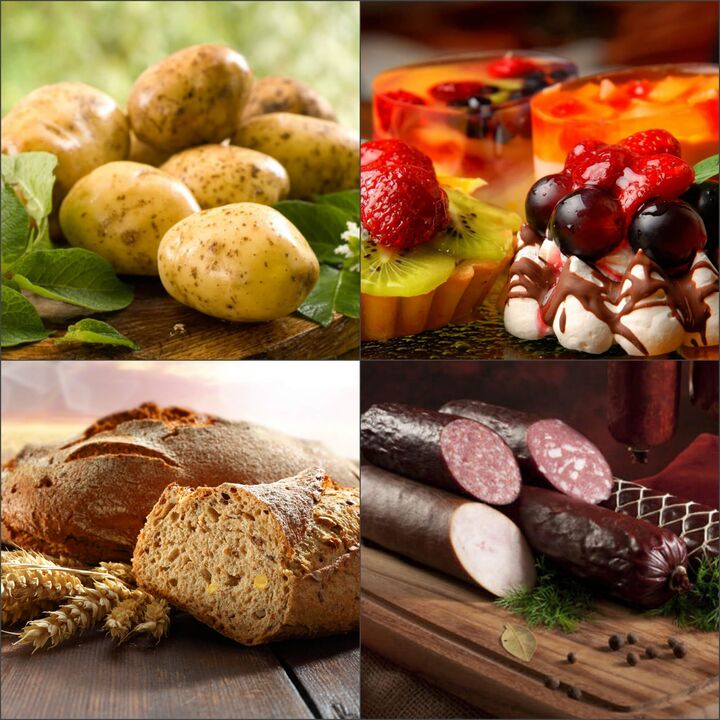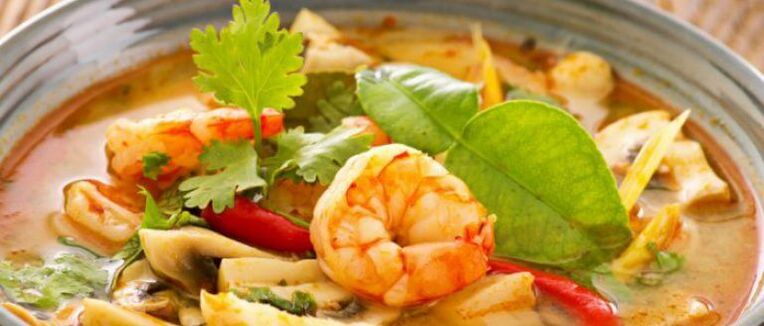As the name suggests, a low-carbohydrate diet is characterized by a decrease in the intake of the required amount of carbohydrates, thereby leading the body to weight loss. There are many examples of such diets: the popular Kremlin low-carb diet, the Protasov diet, the protein diet, the high-fat Atkins diet - all rely on a low carb intake, which reduces the release of insulin in the blood and thus promotes the active breakdown of fats. Most likely, it is not worth talking about the fact that the refusal of sweet, starchy, various, sweets and chocolate fruits will promote weight loss and help to effectively get rid of extra pounds. That is to say, they are simple carbohydrates or, in another way, fast. It is precisely to reduce their consumption that the diet is aimed, which we will discuss later.

The essence and benefits of a low carbohydrate diet
To understand the very essence of the diet, it is important to distinguish how simple carbohydrates differ from complex ones. The fact is that "simple" or "fast" carbohydrates have the ability to be absorbed very quickly and converted into body fat. "Slow" carbohydrates, or as they are also called "complex" carbohydrates, tend to be absorbed at a slow rate, loading the body with vigor and energy, thanks to which a person does not feel hungry for a long time and is able to lose far more calories than he gained with one serving of food.
Simple carbohydrates include: a variety of pastries, sweets, smoked treats, fatty foods, and flour. The use of these products is strictly prohibited. Complex carbohydrates include various grains and all vegetables. But a low-carb diet allows for vegetables and only a small amount of grains and some fruits.
Low-carb diets can be of two types: slow and hard. The former are designed for gradual weight loss. At the same time, later, if you adhere to certain norms in the diet, it is quite possible to avoid the repeated streak of unnecessary kilograms. Strict diets are primarily intended for athletes. Often used by bodybuilders for drying, so its use by an ordinary person can lead to rapid uncontrolled weight gain.
The main advantage of a low-carbohydrate diet is that with its help you can safely lose a decent amount of kilogram irrevocably without suffering from constant hunger. But at the same time, you shouldn't expect quick results. It is a long-term controlled process that will help the body avoid possible unnecessary damage. Such, which is usually accompanied by various "hungry" diets. However, this diet can later become a nutritional system, the basis for a daily diet.
The benefits of a low-carb diet are as follows:
- does not require fabulous costs, as it uses extremely useful and affordable dishes;
- in diabetes mellitus, such a diet helps restore the lipid spectrum, normalizes blood glucose levels, but such a diet can only be used under the supervision of a specialist;
- the diet is unbalanced, but you can safely follow it for a long time, or you can make a lifestyle of it, positioning it as a special nutritional system;
- it is quite in demand among athletes, as it helps burn fat without affecting muscle mass and also gives energy for a long time.

Contraindications and cons of a low carb diet
As large as the system is, it has both advantages and disadvantages. In addition, a low-carbohydrate diet has a number of contraindications:
- it is not recommended to use this diet in childhood and adolescence, as the lack of carbohydrates in a developing body is fraught with unpleasant health consequences;
- during pregnancy and lactation, one should not even resort to such a weight loss system, since for pregnant women the state of health of the fetus is of prime importance, therefore, in principle, they should not follow a diet;
- if there are any health problems, it is necessary to consult a specialist before a diet.
If you follow the principles of a low-carbohydrate diet, you should remember that eating protein foods every day can lead to undesirable consequences in the work of the heart and blood vessels, as well as a large load on the kidneys. This is usually due to the lack of potassium in the body, which in small quantities enters the body with such a diet.
Lack of glucose is undoubtedly one of the disadvantages of a low-carbohydrate diet. This mainly affects mental activity, memory disturbances and a slowing of reaction speed are often noted. It is especially difficult for sweets lovers to come to terms with such a diet. A large percentage of those who drop out of the diet are among these people.
Additionally, protein foods are high in cholesterol, which can build up in the body, and a lack of healthy fiber on the menu can lead to problems in the gut. With a high protein content in the diet, the body begins to produce ketone bodies. They, in turn, are able to expel fat from the body, but at the same time they can also attach themselves to useful substances necessary for the normal and well-coordinated work of important organs and systems. This can often lead to weakness, dizziness, and bouts of insomnia. In this case, you need to consult a doctor, most likely this method of losing weight is not for you.

Since the intake of some useful vegetables is limited with a low-carbohydrate diet, the body may not have the required amount of vitamins and minerals, therefore, the use of additional vitamin complexes is encouraged at this time.
Permitted products
The basis of the menu for a low-carb diet should be protein foods with a small addition of fats and carbohydrates. The following products are allowed:
- lean meat and lean fish;
- egg;
- low-fat fermented milk and dairy products;
- mushrooms;
- seafood;
- various vegetables, if possible excluding potatoes, legumes, and olives and olives;
- a limited amount of fruit, with the exception of grapes and bananas, as they have a rather high calorie content;
- offal;
- dried fruit and nuts;
- buckwheat, oat bran or brown rice in limited quantities;
- various greens.
Forbidden foods

Foods prohibited on a low-carb diet include:
- starchy vegetables and cereals: potatoes, white rice, pasta of all kinds;
- bread and various products from it;
- sweets;
- smoked sausages and other delicacies;
- mayonnaise, ketchup and other fatty sauces;
- sugar in any form;
- grapes and bananas, rich in fructose;
- fruit juices and compotes;
- alcoholic beverages.
Nutritionists compete to insist on banning fatty foods and replacing them with low-fat counterparts, but reviews from numerous adherents and advocates of this weight loss method suggest otherwise. They calmly adhered to this diet and lost weight, eating some types of fatty sausages and meat. Only you have to eat them in moderation, without overdoing it.
Low Carb Diet Guidelines
In order for such a diet to proceed as intended and not harm the body, it is necessary to follow certain rules:
- with such a diet, it is necessary to consume as much liquid as possible - more than one and a half liters per day;
- vegetables are recommended to be cooked, steamed or stewed;
- with such a system, it is desirable to walk for at least twenty minutes a day or to do additional physical activity;
- to correctly compose a daily diet, it is necessary to use a table in which the carbohydrate component of the various products is displayed.
Table of the content of the carbohydrate component in various products per 100 grams
| Products | Points |
|---|---|
| Alcoholic beverages | |
| High alcoholic beverages (rum, whiskey, tequila, vodka and others) | - |
| Dry wine | $ 1 |
| Beer (about 250 grams) | 12 USD |
| Liqueur (about 60 grams) | $ 18 |
| Mushrooms | |
| Fresh champignons | 0, 1 c. u. |
| Fresh morels | 0, 2 c. u. |
| Farfalle, mushrooms and raw mushrooms | 0, 5 cu |
| Fresh milk mushrooms, porcini and porcini | $ 1 |
| Raw chanterelles, porcini and russula | 1, 5 USD |
| Dry porcini mushrooms | $ 7. 5 |
| Dried porcini | $ 13 |
| Dried porcini | $ 14 |
| Canned food | |
| Any fish | - |
| Beetroot caviar | $ 2 |
| Canned beans | $ 2. 5 |
| Pickled cucumbers | $ 3 |
| Tomatoes and seaweed | $ 4 |
| Olives, eggplant caviar | $ 5 |
| Canned peas | 6, 5 cu |
| zucchini caviar | $ 8. 5 |
| Pepper with vegetables | $ 11 |
| Sweet canned corn | $ 14. 5 |
| Tomato paste | $ 19 |
| Cereals | |
| Beans and other legumes | $ 46 |
| Oatmeal | $ 49 |
| Hercules, split peas | $ 50 |
| Buckwheat | $ 62 |
| Pearl barley and millet | $ 66 |
| Barley | $ 67 |
| White rice | $ 71 |
| Dairy product | |
| Vegetable oil | - |
| Lean ricotta, margarine and various types of cheese | $ 1 |
| Butter | $ 1. 3 |
| Types of low-fat cottage cheese | $ 1. 8 |
| Mayonnaise of any fat content | $ 2. 6 |
| High-fat cottage cheese | $ 2. 8 |
| Sour cream of any fat content | $ 3 |
| Sour milk or kefir | $ 3. 2 |
| Sugar Free Yogurt | 3. 5 USD |
| Cream of any fat content | $ 4 |
| Pasteurized and cooked milk | $ 4. 7 |
| Sugary yogurt | $ 8. 5 |
| Sweet curd mass | $ 15 |
| Sweet curd in glaze | 32 USD |
| Meat products, poultry | |
| Different types of meat (lamb, beef, pork, veal), poultry, rabbit, heart and liver of beef, lard, loin and tongue, various steak and sausages, pork legs | - |
| chicken eggs | 0, 5 cu |
| Chicken liver | 1, 5 USD |
| Beef sausages, boiled sausage and milk sausages | 1, 5 USD |
| Pork sausages | $ 2 |
| Breaded meat | $ 5 |
| Meat in batter | 6 USD |
| Beverages | |
| Coffee, unsweetened tea, mineral water | - |
| Tomato juice | 3. 5 USD |
| Carrot juice, xylitol compote | 6 USD |
| Apple juice | $ 7. 5 |
| Grapefruit juice | $ 8 |
| Mandarin juice | $ 9 |
| Plum juice with pulp | $ 11 |
| cherry juice | $ 11. 5 |
| Orange juice | 12 USD |
| Grape, pomegranate and apricot juice | $ 14 |
| Plum juice without pulp | $ 16 |
| compote of pears | $ 18 |
| Compote of grapes and apples | $ 19 |
| Compote of apricots | $ 21 |
| compote of cherries | $ 24 |
| Vegetables, herbs | |
| Daikon | $ 1 |
| Celery, lettuce, spinach | $ 2 |
| Green beans, fresh cucumber, asparagus, sorrel | $ 3 |
| Green onions | 3. 5 USD |
| Pumpkin, courgettes, tomatoes, radishes | $ 4 |
| Eggplant, red, white and cauliflower cabbage, peppers, turnips, garlic | $ 5 |
| Green and red peppers | $ 5 |
| Celery root, wild garlic | 6 USD |
| Leek, radish | 6, 5 cu |
| Rutabaga, carrots | $ 7 |
| Fresh horseradish | $ 7. 5 |
| Beans, kohlrabi, parsley | $ 8 |
| Watermelon, melon, onion, beet | $ 9 |
| parsley root | $ 10. 5 |
| Fresh peas | 12 USD |
| raw potatoes | $ 16 |
| Peanuts | |
| Pine nuts | $ 10 |
| almond | $ 11 |
| Nuts and pumpkin seeds | 12 USD |
| Peanuts, hazelnuts, pistachios | $ 15 |
| Sunflower seeds | $ 18 |
| Coconut and sesame seeds | $ 20 |
| Cashew nuts | $ 25 |
| Seasonings and spices | |
| Red wine vinegar (spoon) | - |
| Herbs (spoon) | 0, 1 c. u. |
| Capers and horseradish (spoon) | $ 0. 4 |
| Cinnamon and ground chilli (teaspoon) | 0, 5 cu |
| Mustard, tartar (spoon) | 0, 5 cu |
| Ginger (spoon) | 0, 8 c. u. |
| Apple cider vinegar and soy sauce (tablespoon) | $ 1 |
| White wine vinegar (spoon) | 1, 5 USD |
| BBQ sauce (spoon) | $ 1. 8 |
| Vinegar (spoon) | $ 2, 3 |
| Tomato sauce (50 grams) | 3. 5 USD |
| Ketchup (spoon) | $ 4 |
| Cranberry sauce (spoon) | 6, 5 cu |
| Seafood, fish | |
| Frozen, fresh, boiled and smoked fish, shrimp, red and black caviar | - |
| Fresh lobster and seaweed | $ 1 |
| fresh crabs | $ 2 |
| fresh squid | $ 4 |
| Fresh mussels | $ 5 |
| Fish in tomato sauce | 6 USD |
| fresh oysters | $ 7 |
| Breaded fish | 12 USD |
| Sweets | |
| Jam for diabetics | $ 3 |
| Jam for diabetics | $ 9 |
| Chocolate ice cream | $ 20 |
| Ice-cream | $ 22 |
| Frozen ice | $ 25 |
| Almond cake | $ 45 |
| Chocolate with nuts | $ 48 |
| Sponge cake and dark chocolate | $ 50 |
| Chocolate candies | $ 51 |
| Milk and white chocolate | $ 54 |
| Halva | $ 55 |
| Condensed milk | $ 56 |
| Cream cake | $ 62 |
| Simple waffles and apple jam | $ 65 |
| apple jam | $ 66 |
| jam, jam | $ 68 |
| Lollipop | $ 70 |
| Strawberry and raspberry jam | $ 71 |
| Honey and butter biscuits | $ 75 |
| Marmalade | $ 76 |
| Cream gingerbread | $ 77 |
| Pastila and fruit waffles | $ 80 |
| Dark (candy) | $ 83 |
| Filled with caramel | $ 92 |
| Sugar of different types | $ 99 |
| soups | |
| Chicken or meat broth | - |
| Goulash soup and green cabbage soup | 12 USD |
| Mushroom soup | $ 15 |
| Pottage | $ 16 |
| Tomato soup | $ 17 |
| Pea soup | $ 20 |
| Fruit | |
| Lemons | $ 3 |
| Cherry plum and grapefruit | 6, 5 cu |
| Quince, orange and mandarins | $ 8 |
| Rowan | $ 8. 5 |
| Dogwood and apricots | $ 9 |
| Pear, peach, plum and apple | $ 9. 5 |
| Kiwi and cherries | $ 10 |
| cherries | $ 10. 5 |
| Pomegranate, chokeberry, fig | $ 11 |
| Pineapple | $ 11. 5 |
| Persimmons and nectarines | $ 13 |
| Bananas | $ 21 |
| dried apples | $ 45 |
| Dried pears | $ 49 |
| Dried apricots | $ 53 |
| Dried apricots | $ 55 |
| plums | $ 58 |
| Raisins | $ 66 |
| Fruit date | $ 68 |
| Bread | |
| soy flour | $ 16 |
| Rye | $ 34 |
| Diabetic | $ 38 |
| Borodinsky | $ 40 |
| Tortillas of bread with cereals and rye | $ 43 |
| Grain | $ 50 |
| Riga and bun | $ 51 |
| Armenian lavash | $ 56 |
| bagel | $ 58 |
| Rye flour with seeds | $ 64 |
| creamy rusks | $ 66 |
| First choice soft wheat flour | $ 67 |
| Sushi, egg noodles and premium wheat flour | $ 68 |
| Sweet straws and pasta | $ 69 |
| corn flour | $ 70 |
| Potato starch | $ 79 |
| Cornstarch | $ 80 |
| Berries | |
| raspberry | 6 USD |
| Strawberry | 6, 5 cu |
| Blueberry | $ 7 |
| Black and red currants | $ 7. 5 |
| Cranberry, raspberry, blueberry and white currant | $ 8 |
| Gooseberry | $ 9 |
| Fresh rosehip | $ 10 |
| Grape | $ 15 |
| Dried rosehip | $ 21. 5 |
Based on the table, you can make a personal menu, adhering to which you can lose up to 9 kilograms in a week.
The construction principle is based on limiting the use of foods containing a large amount of carbohydrates:
- for weight loss - you need to earn up to 40 conventional units per day;
- for weight stabilization - no more than 60 conventional units;
- to increase the kilogram - 60 conventional units and more.
Different types of menus for the week with a low carb diet
A sample menu for a week can be presented as follows:
- breakfast - steamed omelette, green or herbal tea;
- second breakfast - low-fat cottage cheese;
- lunch - mushroom soup, boiled chicken;
- dinner - baked fish.
Slimming menu for the week
To lose about 10 extra pounds in a week, you can try this version of the weekly menu:
- breakfast - cottage cheese with dried fruit;
- lunch - cabbage soup;
- dinner - boiled veal.
Diabetes mellitus weekly menu
A separate medical menu can be used for diabetes mellitus:
- breakfast - low-fat cottage cheese, tea and 2 boiled eggs;
- second breakfast - 250 grams of yogurt;
- lunch - bean soup;
- afternoon tea - orange;
- dinner - baked fish with vegetables.
High-fat, low-carbohydrate diet
This diet was invented by Dr. Atkins. It proceeds in four phases:
- the first phase - duration 2 weeks, restriction in carbohydrates about 20 grams, proteins are allowed in any quantity;
- the second stage - lasts several months, during which it is necessary to gradually increase the amount of carbohydrates consumed in food;
- the third stage: to maintain weight in the current state, it is recommended to increase the rate of available carbohydrates to 10 grams per day;
- fourth phase: to consolidate the result, it is necessary to consume the same amount of carbohydrates as in the third phase.
Sample menu for athletes

To effectively burn fat without losing muscle mass, it is recommended to use the following menu approximately for a week:
- breakfast - tea, oatmeal in milk;
- second breakfast - 200 grams of low-fat cottage cheese;
- lunch - vegetable soup, seafood salad, stewed vegetables;
- afternoon tea - cottage cheese pudding;
- dinner - baked meat, steamed vegetables, kefir.
Low carb diet for vegetarians
There is a separate diet for those people who do not use meat in their diet. There are some rules for them:
- the calculation of the carbohydrates consumed must be done like this: 5 grams of carbohydrates per 10 kilograms of weight;
- meat and seafood products need to be replaced by their soy, bean and grain counterparts.
Protein diet
Such a menu in their diet can be used both by athletes during the drying period and by ordinary people who prefer protein foods:
- breakfast - tea and 100 grams of fat-free cottage cheese;
- second breakfast - zhmenya nuts;
- lunch - boiled chicken with stewed vegetables;
- afternoon tea - kefir or yogurt;
- dinner - fish cooked in a water bath.
Low-carb diet recipes
shrimp soup

To prepare the soup you will need:
- shrimp - 1 kg;
- celery;
- tomato - 1 pc;
- onion - 1 pc;
- curry;
- lemon juice.
Peel the prawns and rinse them well, finely chop the vegetables and herbs. Pour water over the ingredients, add a little curry, sprinkle with lemon juice and put on the stove.
Beef stew with spinach
To prepare such a dish, you can use the following recipe:
- beef - 1 kg;
- spinach - 400 grams;
- onion - 1 pc;
- celery root - 200 grams;
- garlic - 1 clove;
- tomatoes - 2 pcs. ;
- olive oil;
- cumin;
- ginger powder;
- beef broth - 250 grams.
Fry all seasonings in oil, gradually add chopped onions and tomatoes. Sauté a little, add the beef broth and other ingredients. It is best to cut the meat into strips so that it takes less time to cook. Cover the dish and simmer for forty minutes.
conclusions
Reviews on the low carb diet are mixed, with many supporters and many opponents alike. However, both those and those notice its effectiveness. Such a diet is suitable for those who do not like exhausting fasting, because it allows you to eat a lot of foods. Its advantages include its effective use in case of diabetes mellitus. As a remedy, it has proven itself quite well. Plus, it's affordable and won't hit the family budget hard. In a word, if you use such a system specifically for weight loss, it will undoubtedly lead to amazing results. However, it is worth remembering that such a diet, although not a mono diet, but its indicators are unbalanced, therefore, before embarking on a course of such fasting, it is imperative to consult a specialist, especially if there are chronic diseases in history .
































